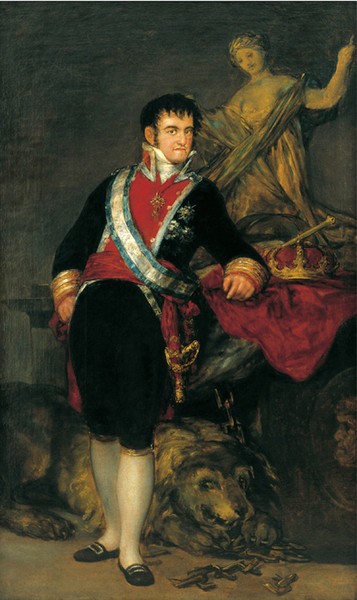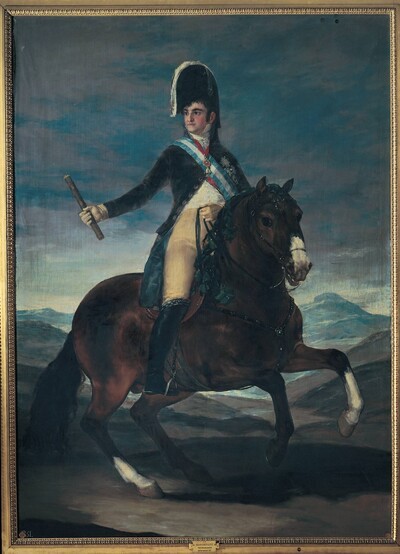- Cronología
- 1814
- Ubicación
- MAS, Museum of Modern and Contemporary Art of de Santander and Cantabria, Santander, Spain
- Dimensiones
- 225 x 124 cm
- Técnica y soporte
- Oil on canvas
- Reconocimiento de la autoría de Goya
- Documented work
- Titular
- MAS, Museum of Modern and Contemporary Art of Santander and Cantabria
- Ficha: realización/revisión
- 14 Apr 2010 / 16 Jun 2023
Following Ferdinand VII's period of captivity in Valençay (France), the Municipal Council of Santander decided to commission Goya to paint a portrait of the monarch, to be hung in the town hall.
The council gave the following specifications for the portrait: "The painting must be seven feet tall and of proportional width. The portrait must be full-length and frontal; in the dress of Colonel of the Guard and with the royal insignia. He should have one hand resting on the pedestal of a statue of Spain, crowned with a laurel wreath, and on this pedestal must be the sceptre, the crown and the robe: at its base, a lion with broken chains in its claws. The work on the head must be very carefully done and a close likeness is desired". The artist was also requested to complete the work as quickly as possible, to which Goya responded that he would need at least fifteen days, charging for the job 8,000 reales, which would have been paid once work had finished. He signed a receipt for this very amount on 1 December 1814.
Until the death of the king, this painting remained on display in the meeting room of Santander city hall. It was later forgotten for a time until it entered the collection of the municipal fine art museum.
This portrait depicts Ferdinand VII wearing several medals and honours, including the blue and white sash of the Order of Charles III, and the large insignia of the Order of the Golden Fleece that hangs around his neck.In the background we see a statue on top of a pedestal.
This is the allegory of Spain, wearing a laurel wreath and baring her breasts. When the painting was made, she would have been crowing the king with her right hand. According to Salvador Carretero, she symbolizes the constitutional mother of the Spanish people. However, in view of the events occurring in Spain following the arrival of the monarch (the abolition of the Constitution of 1812, the restoration of the Inquisition, etc.) and which resulted in the crushing of the liberal regime, Goya made some changes to this portrait, including the removal of Ferdinand VII's laurel wreath. The figure of the lion at the king's feet would have symbolized the liberation of the Spanish people with the expulsion of the French troops.
The king is resting his left arm on the ermine-lined robes of state, on top of which sit the crown and the baton, the symbols of his royal power.The vividness of the colours, especially the red of the king's waistcoat and the ermine robe, are particularly striking and lend the painting a luminous feeling. As in so many of Goya's portraits, the brushstrokes are thickly applied.
For further biographical information, see Ferdinand VII.
The painting was restored in 1947.
-
GoyaFestival Internacional de Granada, Palacio de Carlos VGranada1955consultant editor Enrique Lafuente Ferraricat. 114
-
De Tiépolo à GoyaGalerie des Beaux-ArtsBurdeos1956consultant editor Gilberte Martin-Méry. From May 7th to July 31st 1956cat. 123
-
Francisco de Goya. IV Centenario de la capitalidadorganized by Ayuntamiento de Madrid and Dirección General de Bellas Artes at the Casón del Buen RetiroMadrid1961consultant editor Valentín de Sambriciocat. X
-
cat. 71
-
Goya and his timesThe Royal Academy of ArtsLondon1963cat. 66cat. 107
-
GoyaKoninklijk Kabinet van Schilderijen MauritshuisThe Hauge1970organized by Ministerio de Estado y Asuntos Culturales and Réunion des Musées Nationaux, July 4th to September 13th 1970. Exhibited also at the Musée de l’Orangerie des Tuileries, Paris, October 25th to December 7th 1970, consultant editors Jeannine Baticle and A. B. de Vriescat. 45
-
De Greco á Picasso. Cinq siècles d’art espagnolMusée du Petit PalaisParís1987from October 10th 1987 to January 3th 1988cat. 109
-
Goya y el espíritu de la IlustraciónMuseo Nacional del PradoMadrid1988from October 6th to December 18th 1988. Exhibited also at Museum of Fine Arts, Boston, January 18th to March 26th 1989; The Metropolitan Museum of Art, Nueva York, May 9th to July 16th 1989, Madrid curator Manuela B. Mena Marqués, scientific directors Alfonso E. Pérez Sánchez and Eleanor A. Sayrecat. 118
-
GoyaLa Lonja, Torreón Fortea y Museo Pablo GargalloZaragoza1992consultant editor Julián Gállegocat. 45
-
Realidad e imagen. Goya 1746 – 1828Museo de ZaragozaZaragoza1996consultant editor Federico Torralba Soriano. From October 3th to December 1st 1996cat. 60
-
Un retrato de Fernando VII por GoyaBoletín de la Biblioteca Menendez y Pelayo1919pp. 23 -60
-
Francisco de Goya, IV Centenario de la CapitalidadMadridExcmo. Ayuntamiento de Madrid y Dirección General de Bellas Artes1961pp. 27 y 28, cat. X
-
Vie et ouvre de Francisco de GoyaParísOffice du livre1970p. 297
-
BarcelonaPolígrafa1970vol. I, p. 361, cat. 630
-
Francisco de Goya, 4 vols.ZaragozaCaja de Ahorros de Zaragoza, Aragón y Rioja1980-1982vol. IV, p. 35
-
Goya y el espíritu de la IlustraciónMadridMuseo del Prado1988pp. 366, 367 (il.) y 368, cat. 118
-
GoyaZaragozaElecta1992pp. 122 y 123 (il.), cat. 45
-
Realidad e imagen. Goya 1746 – 1828MadridGobierno de Aragón y Electa España1996pp. 170 y 171, cat. 60
-
El Fernando VII de Francisco de Goya del Museo de Bellas Artes de SantanderTrasdósMuseo de Arte Moderno y Contemporáneo de Santander y Cantabria /MAS2008pp. 152-169






